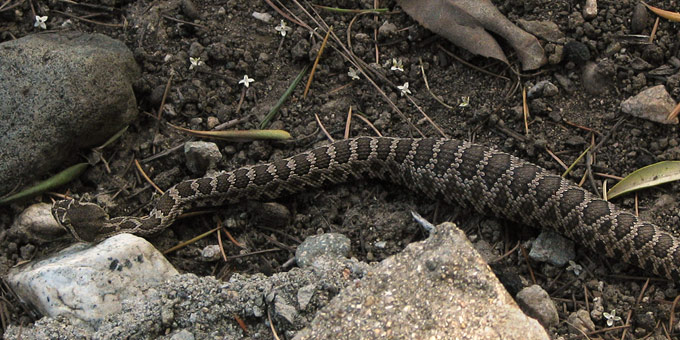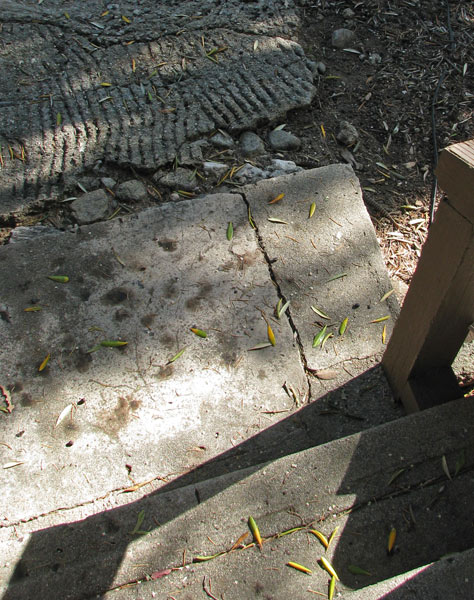Spring Snakes (Part I)
 Southern Pacific Rattlesnake (Crotalus oreganus helleri)
Southern Pacific Rattlesnake (Crotalus oreganus helleri)
This past Friday afternoon, we were leaving the house to run a few errands. I scanned the steps before walking down them (as I have learned to do) and quickly spotted this immature rattlesnake. It was on the small size at about a foot long, though I have certainly seen them smaller. It was perfectly still and — despite being relatively out in the open — its cryptic coloration made it difficult to pick out from the background. After grabbing a long stick that I keep on the porch (for just such reasons), I carefully walked past it, making sure to lead with the stick. I have NEVER had a rattlesnake try to bite me or be in any way aggressive, but if I have to get this close to them and for some reason the snake were to feel threatened, I think it’s smart to give them something to strike at (other than my foot). As is often the case, this snake didn’t seem the least bit concerned by me, and once I was a few feet passed it, I stopped to have a good look and take some pictures. The first thing I noticed was the obvious bulge in its abdomen. According to my favorite website, California Herps, Southern Pacific Rattlesnake eat “birds, lizards, snakes, frogs, insects, and small mammals, including mice, rats, rabbits, hares, and ground squirrels”. Knowing what’s readily available around our porch and the size of the snake, I would not be at all surprised if its last victim had been a fence lizard (a Great Basin Fence Lizard, Sceloporus occidentalis longipes, to be exact). That’s just speculation, of course, we also have good-sized populations of several of the other prey animals on that list. A mouse would be entirely plausible too.) I had never observed a snake in the process of digesting a meal before and I was tickled to be able to get a few photos. Fortunately, when we returned home an hour or so later, this little one had moved on to a less trafficked area.
Just for fun, I thought I’d include this image I took before I headed down the steps. Can you see the snake? If you can’t, click on the image to see a highlighted version… Oh, but it would be so much easier if they were neon yellow! (*chuckle*) Well, easier for me! Undoubtedly much harder on the snake, who makes its way in the world by being difficult for both predators and prey to see.

I noticed that bulge right away but I wouldn’t have in person being that the snake is so small. I hope it ate a mouse, that’s one good reason to like them, well maybe respect is a better word. We never killed them as some do we would carefully remove them to a more remote destination, like Webb Canyon 🙂 🙂 A lady I knew lived in the hills and watched one eat a squirrel you can imagine how grotesque it’s bulge was! I haven’t seen any this year and one reason I like to hike early when it’s still cool. When we lived in MB and Bryce was little he rescued a lizard from a garter snake in our garden, funny boy! I know you have “snake eyes” but be careful………
Afternoon, Ro!! Oh, so YOU’RE the one who’s responsible for all the rattlesnakes in our canyon?!! LOL! Yeah… I guess some days it does feel a little dicey to have so many of them hanging around. I’m pretty sure that they breed in the crawlspace under the cabin. But, we have soooo many mice and rats around the cabin too, that I do often feel grateful for the snakes, which undoubtedly help to reduce the rodent numbers. Hey, did you know that adult CA ground squirrels supposedly have a myriad of defense strategies for dealing with rattlesnakes? They are known to chew on and rub themselves with shed rattlesnake skins as a means of cloaking themselves in its scent. They also direct extra blood flow to their tails to make their aggressive twitching displays more noticeable and intimidating to the snake’s infrared view of the world. Some local populations are said to be immune to the venom entirely. Of course, this is just in the adults, the young squirrels are still quite vulnerable and are regularly preyed on. P.S. Tell Bryce he’s a guy after my own heart… I know that everything out there has to eat, but sometimes it’s hard for us tender-hearted souls to stand-by and watch. 🙂
Harsi, what fascinating facts about adult CA ground squirrels! The only snakes I come across are garter snakes that are sunning themselves….and that is not often. The females can bite if they are feeling ornery, but it doesn’t hurt too much. They give off an offensive smell because they want you to put them down 🙂 P.S. I liked your neon snake. That was fun clicking on the photo!
Hey Lisa! You may not come across garter snake frequently… but I NEVER see them. It’s weird because I know they can be a pretty commonly encountered snake and I’m certain they must be here in the canyon. Still, I’ve yet to see one. 🙁 I’m glad you found the squirrel info interesting… and “thank you” for teaching ME something new! I didn’t know that about the stinky odor as a means of self-defense.
The liquid that the garter snake secretes is yellow-ish, and of course, meant to be a deterrent to predators in general. It comes from a special gland –but I don’t know if that gland serves other purposes too. (?) On New England stone walls, they are a pretty common site (for good observers) this time of year because they are craving the warmth of the sun.
Thanks for the cool info, Lisa!!! 🙂 I decided to do some reading on the subject and here’s what I found out… Garter snakes can apparently not only release the contents of their cloacal glands (they come in pairs) but some may also expel musk from their anal gland. If I’m understanding what I read correctly, defense does seem to be the primary function for these secretions, and perhaps the sole reason for the existence of the cloacal glands.